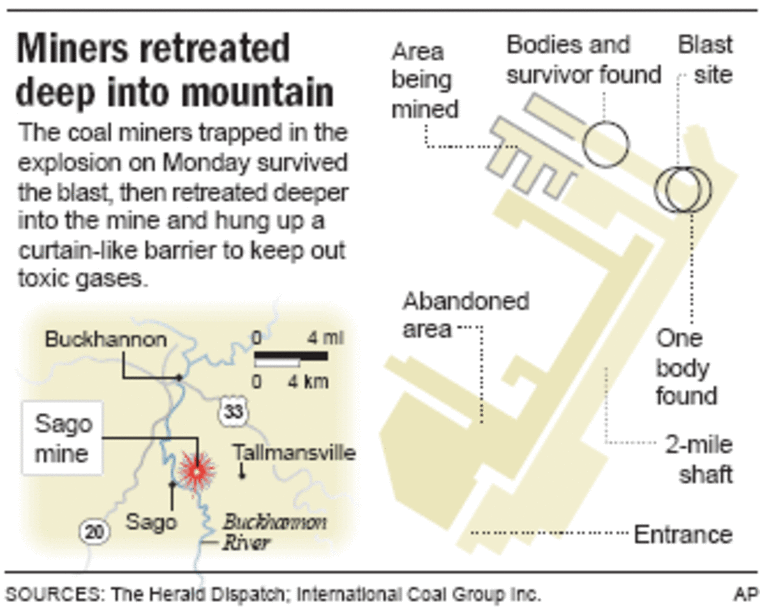Footprints inside the Sago Mine indicate the trapped miners tried to use a mechanized mine car to force their way out after the explosion, family members of the sole survivor said.
Rick McGee, the brother-in-law of survivor Randal McCloy Jr., said Tuesday that International Coal Group Inc. chief executive Ben Hatfield had shared the information with the family.
“They found footprints,” McGee said. The men “tried to go back out of the mine. This ain’t hearsay. This came from Hatfield’s mouth.”
Lara Ramsburg, a spokeswoman for Gov. Joe Manchin, said Tuesday that it’s also the state’s understanding that the men tried to escape. When they couldn’t, “they then, being trained, turned around and went back to the face, where they barricaded themselves,” she said. In a mine, the “face” is where miners are removing coal.
By the time rescue workers reached the 12 trapped miners more than 41 hours after the Jan. 2 explosion, all but one had died of carbon monoxide poisoning. It was West Virginia’s worst coal-mining accident in more than 35 years.
Violation details released
The federal Mine Safety and Health Administration released documents Tuesday related to 17 of the 208 alleged safety violations at the mine in 2005.
In the details of one report, dated Dec. 14, an MSHA inspector said a failure to address coal dust and excessive amounts of loose coal — in some places 29 inches deep — “showed a high degree of negligence for the health and safety of the miners.”
That area of the mine was not involved in last week’s explosion and the problem was corrected by scooping up the loose coal and covering the area with rock dust.
According to the documents released Tuesday, the company contested nine of the 17 violations, which included accumulation of loose coal and coal dust, and problems with ventilation and roof supports.
Calls to an ICG spokesman were not immediately returned.
Survivor’s condition
McCloy, 26, remained in critical condition Wednesday morning, said a spokeswoman at West Virginia University’s Ruby Memorial Hospital in Morgantown. His doctors said Tuesday that tests showed a lot of activity on both sides of McCloy’s brain.
“It is probably too early for us to tell what that means, but it is very important to us that he has a lot of brain activity,” said Dr. Julian Bailes, a neurosurgeon treating McCloy.
Doctors believe McCloy suffered brain damage from his exposure. “He is likely one of the longest survivors of this sort of exposure, not only carbon monoxide, but the other circumstances in the mine,” Bailes said.
Doctors don’t seem concerned that McCloy hasn’t fully awakened yet and say it could be a lengthy, gradual process.
Several doctors said this week they had never heard of anyone breathing carbon monoxide as long as McCloy and surviving. They note it’s possible McCloy also inhaled other toxic gases in the mine as well.
Miners in escape bid? Hatfield did not return repeated requests for comment about whether the miners made an escape effort. In a statement issued to The Associated Press, he said it was probable the miners believed a fire or debris from the explosion was blocking their path.

In the days since the accident, Hatfield has said it’s possible the men could have walked to a section of the mine with clean air, and then made their way out.
In an interview with USA Today, Hatfield said if the trapped miners had wireless communication devices, it would have been possible to tell them of a safe way out. The only method of communication at Sago, a wired phone, was destroyed in the blast.
Hatfield told USA Today his company would consider issuing radios to miners. In response to questions from the AP, the company declined to say if it has made changes in safety procedures at its other mines.
Richard Gates, the federal Mine Safety and Health Administration’s lead investigator into the accident, said he hoped the venting at the mine, including the removal of methane gas in a section of the mine where the explosion apparently occurred, would be complete within a week. Until then, no one will be allowed inside.
Two more funerals were held for the Sago miners on Tuesday. Fred Ware, 59, was remembered at Sago Baptist Church, the small church near the mine where families gathered to await word on the fate of their loved ones. A funeral for Terry Helms, 50, followed later in Masontown. Other funerals were held Sunday and Monday.
E-mail scam discovered
Meanwhile, authorities were investigating an e-mail scam apparently meant to capitalize on donations sent on McCloy's behalf.
West Virginia University reported Wednesday that several people told university hospital officials that they had received e-mails — first thought to be from a hospital doctor — seeking donations to support McCloy's care.
Authorities said the messages were fake and appeared to have originated in India. Neither the hospital or its staff is seeking donations to pay for McCloy's care, and the hospital said it contacted the FBI.